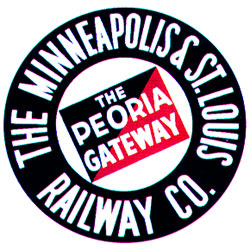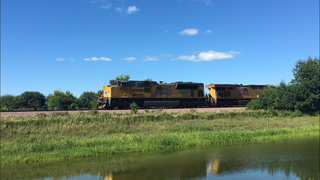Related Research Articles

The Chicago, Milwaukee, St. Paul and Pacific Railroad (CMStP&P), better known as the Milwaukee Road, was a Class I railroad that operated in the Midwest and Northwest of the United States from 1847 until 1986.

The Chicago Great Western Railway was a Class I railroad that linked Chicago, Minneapolis, Omaha, and Kansas City. It was founded by Alpheus Beede Stickney in 1885 as a regional line between St. Paul and the Iowa state line called the Minnesota and Northwestern Railroad. Through mergers and new construction, the railroad, named Chicago Great Western after 1892, quickly became a multi-state carrier. One of the last Class I railroads to be built, it competed against several other more well-established railroads in the same territory, and developed a corporate culture of innovation and efficiency to survive.

The Wisconsin and Southern Railroad is a Class II regional railroad in Southern Wisconsin and Northeastern Illinois currently operated by Watco. It operates former Chicago, Milwaukee, St. Paul and Pacific Railroad and Chicago and North Western Railway (C&NW) trackage, mostly acquired by the state of Wisconsin in the 1980s.

The Chicago and North Western was a Class I railroad in the Midwestern United States. It was also known as the "North Western". The railroad operated more than 5,000 miles (8,000 km) of track at the turn of the 20th century, and over 12,000 miles (19,000 km) of track in seven states before retrenchment in the late 1970s. Until 1972, when the employees purchased the company, it was named the Chicago and North Western Railway.

The Grand Trunk Western Railroad Company was an American subsidiary of the Grand Trunk Railway, later of the Canadian National Railway operating in Michigan, Illinois, Indiana, and Ohio. Since a corporate restructuring in 1971, the railroad has been under CN's subsidiary holding company, the Grand Trunk Corporation. Grand Trunk Western's routes are part of CN's Michigan Division. Its primary mainline between Chicago and Port Huron, Michigan serves as a connection between railroad interchanges in Chicago and rail lines in eastern Canada and the Northeastern United States. The railroad's extensive trackage in Detroit and across southern Michigan has made it an essential link for the automotive industry as a hauler of parts and automobiles from manufacturing plants.

The Minneapolis, Northfield and Southern Railway was an 87-mile (140 km) long American shortline railroad connecting Minneapolis and Northfield, Minnesota. It was incorporated in 1918 to take over the trackage of the former Minneapolis, St. Paul, Rochester and Dubuque Electric Traction Company, also known as the Dan Patch Lines. On June 2, 1982, it was acquired by the Soo Line Railroad, which operated it as a separate railroad until merging it on January 1, 1986, along with the Chicago, Milwaukee, St. Paul and Pacific Railroad.

The Michigan Central Railroad was originally incorporated in 1846 to establish rail service between Detroit, Michigan, and St. Joseph, Michigan. The railroad later operated in the states of Michigan, Indiana, and Illinois in the United States and the province of Ontario in Canada. After about 1867 the railroad was controlled by the New York Central Railroad, which later became part of Penn Central and then Conrail. After the 1998 Conrail breakup, Norfolk Southern Railway now owns much of the former Michigan Central trackage.

The Chicago and Western Indiana Railroad was the owner of Dearborn Station in Chicago and the trackage leading to it. It was owned equally by five of the railroads using it to reach the terminal, and kept those companies from needing their own lines into the city. With the closure of Dearborn Station in 1971 and the Calumet steel mills in 1985, the railroad was gradually downgraded until 1994 when it became a subsidiary of the Union Pacific Corporation.

The Chicago, St. Paul, Minneapolis and Omaha Railway or Omaha Road was a railroad in the U.S. states of Nebraska, Iowa, Minnesota, Wisconsin and South Dakota. It was incorporated in 1880 as a consolidation of the Chicago, St. Paul and Minneapolis Railway and the North Wisconsin Railway. The Chicago and North Western Railway (C&NW) gained control in 1882. The C&NW leased the Omaha Road in 1957 and merged the company into itself in 1972. Portions of the C. St. P. M. and O. are part of the Union Pacific Railroad network. This includes main lines from Wyeville, Wisconsin, to St. Paul, Minnesota, and St. Paul to Sioux City, Iowa.

The Minneapolis and St. Louis Railway (M&StL) was an American Class I railroad that built and operated lines radiating south and west from Minneapolis, Minnesota for 90 years from 1870 to 1960. The railway never reached St. Louis but its North Star Limited passenger train ran to that city via the Wabash Railroad.
The Fremont, Elkhorn and Missouri Valley Railroad (FE&MV), sometimes called "the Elkhorn," was a railroad established in 1869 in the state of Nebraska in the Midwestern United States.

The Cannon Valley Trail is a paved rail trail that follows the Cannon River in southeast Minnesota. The trail follows an abandoned Chicago Great Western Railway corridor for 20 miles (32 km) between Cannon Falls, Minnesota and Red Wing, Minnesota. In the spring, summer, and fall months, the trail is open to hiking, biking, and inline skating. In the winter months, the trail is groomed for cross-country skiing.

Sakatah Singing Hills State Trail is a 41-mile-long (66 km) paved multi-use rail trail connecting Faribault and Mankato, Minnesota. It is maintained by the Minnesota Department of Natural Resources, which converted it from a railroad line. The name derives from the Dakota people who lived in the region; "Sakatah" translates into "singing hills". It began as a snowmobile trail and is now shared by hikers, joggers and cross-country skiers. There are sections of parallel dirt trail for horseback riders but they are not continuous. The landscape is mostly cultivated land with remnant stands of prairie and Big Woods. The trail passes through Sakatah Lake State Park and runs through city streets in Waterville.

Tunnel City is an unincorporated census-designated place in the town of Greenfield, Monroe County, Wisconsin, United States, named after the train tunnel through a hill just to the west of town.
The Litchfield and Madison Railway was a Class I railroad in Illinois in the United States. Its nickname was the St. Louis Gateway Route. The railroad operated 44 miles (71 km) of track from its creation in 1900 until it was absorbed by the Chicago and North Western Railway in 1958.

The Wabash Railroad was a Class I railroad that operated in the mid-central United States. It served a large area, including track in the states of Ohio, Indiana, Illinois, Iowa, Michigan, and Missouri and the province of Ontario. Its primary connections included Chicago, Illinois; Kansas City, Missouri; Detroit, Michigan; Buffalo, New York; St. Louis, Missouri; and Toledo, Ohio.

The Altoona Subdivision or Altoona Sub is a 90.7-mile (146.0 km) railway line owned and operated by the Union Pacific Railroad in the states of Minnesota and Wisconsin. The line originates in Saint Paul, Minnesota, crosses the St. Croix River on the Hudson Bridge into Hudson, Wisconsin, and eventually terminates in Altoona, Wisconsin where it connects to the Wyeville Subdivision. This subdivision is formerly a Chicago and North Western Railway (C&NW) mainline, on which the Twin Cities 400 operated in the mid 1900s.

The Winona Subdivision or Winona Sub is a railway line operated by Union Pacific Railroad. The Union Pacific owns 1.8 miles (2.9 km) of rail in downtown Winona, Minnesota. The UP reaches Winona using the River Subdivision and Tomah Subdivision of the Canadian Pacific Railway. The railroad services the Winona Terminal area on the Mississippi River.
References
- Notes
- ↑ Grant 1984 , p. 14-5
- ↑ Schweihs 2007 , p. 60
- ↑ Finch 1985 , pp. 28–29, 52–53
- ↑ Finch 1985 , pp. 25–26
- 1 2 Schweihs 2007 , p. 62
- ↑ Grant 1984 , p. 89
- ↑ Finch 1985 , pp. 29–31
- ↑ Huddleston, Jerry. "The Hole in Stickney's Pocketbook: CGW's Winston Tunnel".
- ↑ Hensal, Jeffrey (October 30, 2003). "Plan of Work: Apple River Canyon State Park" (PDF).
- ↑ "Environmental Reviews Completed" (PDF). The Environmental Reporter. Vol. 14, no. 12. The Illinois Department of Natural Resources. July 1, 2005. Archived from the original (PDF) on June 22, 2006.
- Sources
- Finch, C. W. (1985). The CGW Winston Tunnel and its Ghost. Newell, Iowa: Bireline Company.
- Grant, H. Roger (1984). The Corn Belt Route: A History of the Chicago Great Western Railroad Company. DeKalb, Illinois: Northern Illinois University Press. ISBN 978-0875800950.
- Schweihs, Maggie (2007). "Essence of Winston Tunnel Lingers". The Galenian. No. Fall/Winter 2006–2007.